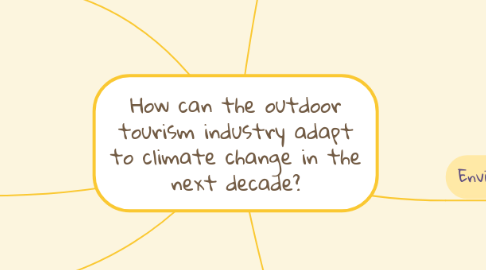
1. Economics
1.1. Tourism Marketing Business Plans ( Tourism Opportunity Strategy, Tourism Development Plans, Business to business joint ventures, familiarization- education), product development)
1.2. Opportunity Cost of climate change
1.3. (KN) Natural resources
1.4. Logit analysis
1.5. Tourism demand - simulation model
1.6. Tourism Opportunity Strategy
2. Environmental Science
2.1. Thermal Environment ( Energy balance equation for heat stress ; M + W + R + C + ED + ERe + ESw + S = 0) Human - Bio meteorological assessment of the thermal environment ) Mayer and Matzarakis , 2003
2.2. Thermal Environment
2.2.1. Heat affects species distribution
2.2.2. Hydro logical systems alteration leading to mobile dune systems --> Loss in biodiversity
2.2.3. Wildfire in forest
2.2.3.1. ' Lightning, which causes up to 35% of Canada's wildfires and is responsible for 85% of the area burned annually, increases as temperature rise, with studies showing 12% more lighting strikes for each degree celsius of warming' ( David Suzuki Foundation )
2.2.3.2. Drier and shorter winters --> earlier snowmelt --> extend fire season
2.3. Impact on crucial natural elements ( temperature, number of sun hours, precipitation, wind, humidity and fog ( Martin, 2004, P572))
2.3.1. Winter index ( W Ln) derived annually on the frequency of air frost ( An) and snow lying days ( Sn) : WLn = ( An - A) / SD A + ( Sn - S) / SDs
2.4. Ecological Footprint to assess tourism Sustainability
2.4.1. Methodological Framework based on an effective footprint calculation
2.4.1.1. Location ( Dcs Vs LDCs)
3. Education
3.1. Changing perspectives and perceptions --> Change in behavior --> Conservation and sustainability
4. Psychology
4.1. Motivation of travel ( Push and pull factors ) Kai Liang's paper
4.2. Destination Image - Tourist perceptions and destination choice
5. Sustainable technology advancement
5.1. Foresight of climatological alterations
5.1.1. Snow model to predict the amount of snow fall M = K(( 1.88 + 0.007R)(9/5T) + 1.27)) snow model developed by the US Army Corps of Engineers

